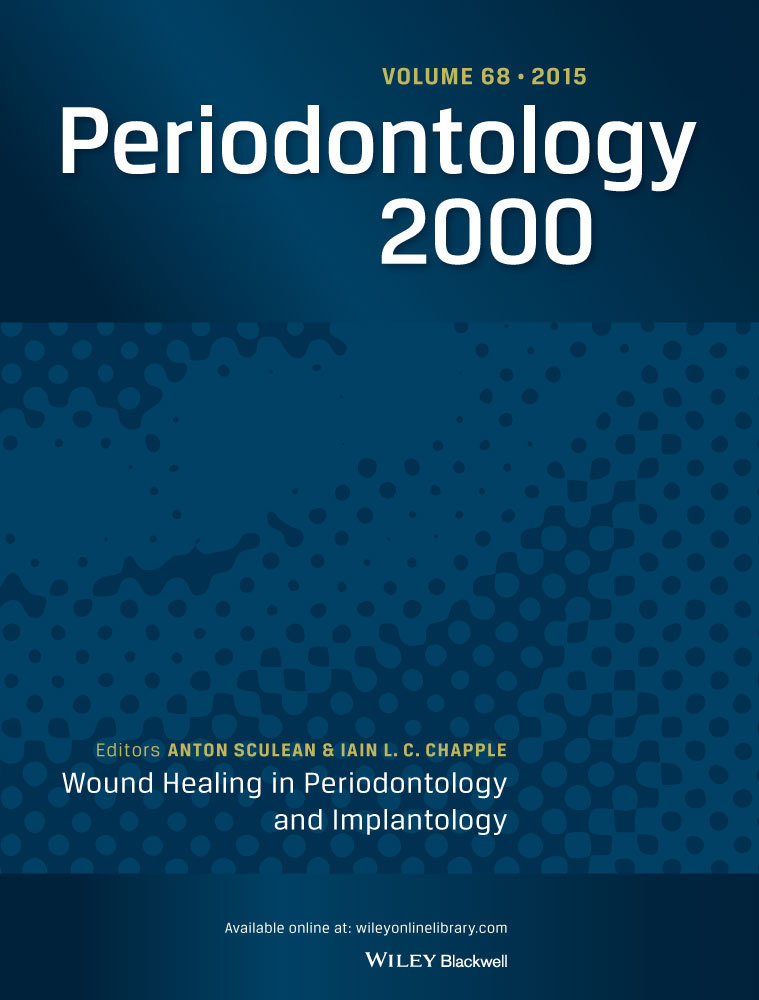Long-term clinical outcomes of periodontal regeneration of intrabony defects: A systematic review and meta-analysis.
IF 15.7
1区 医学
Q1 DENTISTRY, ORAL SURGERY & MEDICINE
引用次数: 0
Abstract
This systematic review and meta-analysis aimed to evaluate the long-term clinical outcomes of regenerative procedures compared with access flap surgery for the treatment of intrabony defects, with a minimum follow-up period of 5 years. A systematic review protocol following PRISMA guidelines was conducted. Both electronic and manual searches were conducted to identify randomized clinical trials (RCTs) on regenerative treatment of deep intrabony defects (≥3 mm) with a follow-up of at least 5 years. Primary outcome variables were probing depth (PD) reduction, clinical attachment level (CAL) gain, recession depth (REC) and tooth loss. Meta-analyses and meta-regressions were performed using random-effects models. Seventeen RCTs published from 2004 to 2022, accounting for 501 defects, with follow-ups ranging from 5 to 20 years, were included. Thirteen studies with some concerns and four with high risks of bias were identified. Meta-analyses revealed that after ≥5 years of follow-up, guided tissue regeneration (GTR) on the intrabony defect resulted in significant CAL gain (3.27 mm; 95% CI: 2.90-3.65) and PD reduction (4.04 mm; 95% CI: 3.69-4.38) compared with baseline. After ≥5 years, regenerative procedures with biologics, bone grafts, or both showed significant improvements in CAL gain (3.21 mm; 95% CI: 2.72-3.70) and PD reduction (3.92 mm; 95% CI: 3.39-4.44). GTR on the intrabony defects obtained higher long-term CAL gain (1.52 mm; 95% CI: 0.06-3.10) and PD reduction (0.89 mm; 95% CI: 0.22-1.99) than OFD (open flap debridement); however, none of the outcomes reached statistical significance (p = 0.06; p = 0.115). Meta-regression identified significant associations between outcomes and factors, such as follow-up time, surgical technique, membrane type, and baseline measurements. The certainty of evidence was low for CAL and PD outcomes, but high for REC. Long-term studies indicate that regenerative procedures for the intrabony defects, particularly GTR, provide significant improvements in clinical parameters compared with baseline. However, the evidence does not conclusively demonstrate the superiority of regenerative approaches over OFD in the long term.骨内缺损牙周再生的长期临床结果:一项系统回顾和荟萃分析。
本系统综述和荟萃分析旨在评估再生手术与通道皮瓣手术治疗骨内缺损的长期临床结果,随访时间至少为5年。遵循PRISMA指南进行了系统审查方案。通过电子和人工检索来确定再生治疗骨深部缺损(≥3mm)的随机临床试验(rct),随访时间至少为5年。主要结果变量为探牙深度(PD)减少、临床附着水平(CAL)增加、退牙深度(REC)和牙齿脱落。采用随机效应模型进行meta分析和meta回归。从2004年到2022年发表的17项随机对照试验,涉及501个缺陷,随访时间从5年到20年不等。13项研究存在一些问题,4项研究存在高偏倚风险。荟萃分析显示,随访≥5年后,骨内缺损的引导组织再生(GTR)与基线相比,CAL显著增加(3.27 mm; 95% CI: 2.90-3.65), PD显著减少(4.04 mm; 95% CI: 3.69-4.38)。≥5年后,采用生物制剂、骨移植物或两者同时进行的再生手术显示出CAL增加(3.21 mm; 95% CI: 2.72-3.70)和PD减少(3.92 mm; 95% CI: 3.39-4.44)的显著改善。GTR对骨内缺损的长期CAL增益(1.52 mm, 95% CI: 0.06-3.10)和PD降低(0.89 mm, 95% CI: 0.22-1.99)高于OFD(开放式皮瓣清创);然而,所有结果均无统计学意义(p = 0.06; p = 0.115)。meta回归发现结果与随访时间、手术技术、膜类型和基线测量等因素之间存在显著关联。CAL和PD结果的证据确定性较低,但REC结果的证据确定性较高。长期研究表明,骨内缺陷的再生手术,特别是GTR,与基线相比,可显著改善临床参数。然而,从长远来看,证据并不能决定性地证明再生方法优于OFD。
本文章由计算机程序翻译,如有差异,请以英文原文为准。
求助全文
约1分钟内获得全文
求助全文
来源期刊

Periodontology 2000
医学-牙科与口腔外科
CiteScore
34.10
自引率
2.20%
发文量
62
审稿时长
>12 weeks
期刊介绍:
Periodontology 2000 is a series of monographs designed for periodontists and general practitioners interested in periodontics. The editorial board selects significant topics and distinguished scientists and clinicians for each monograph. Serving as a valuable supplement to existing periodontal journals, three monographs are published annually, contributing specialized insights to the field.
 求助内容:
求助内容: 应助结果提醒方式:
应助结果提醒方式:


